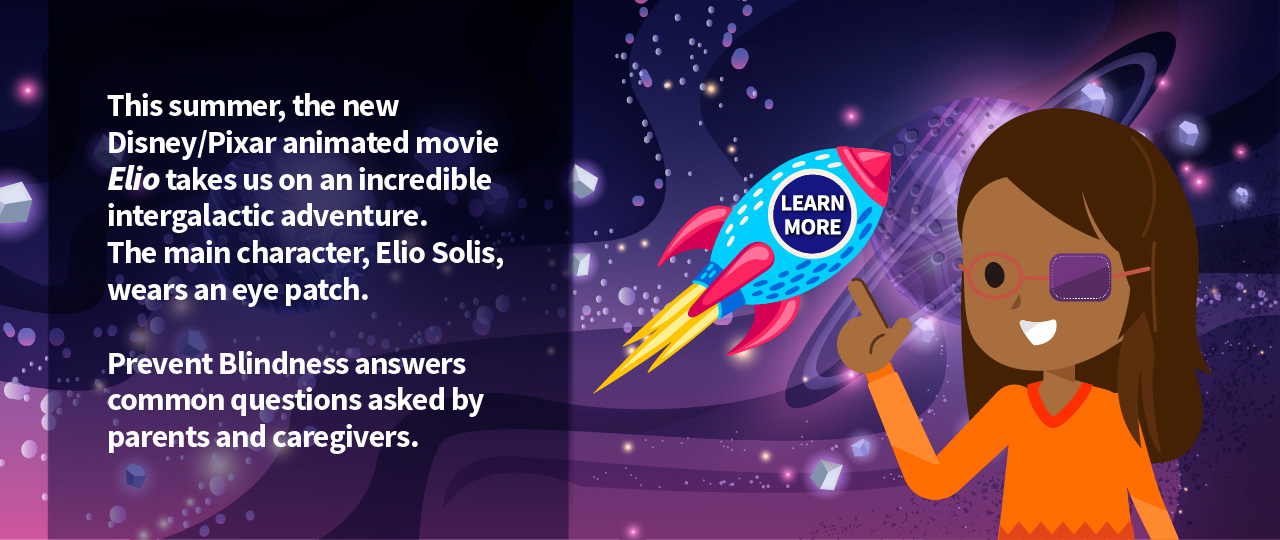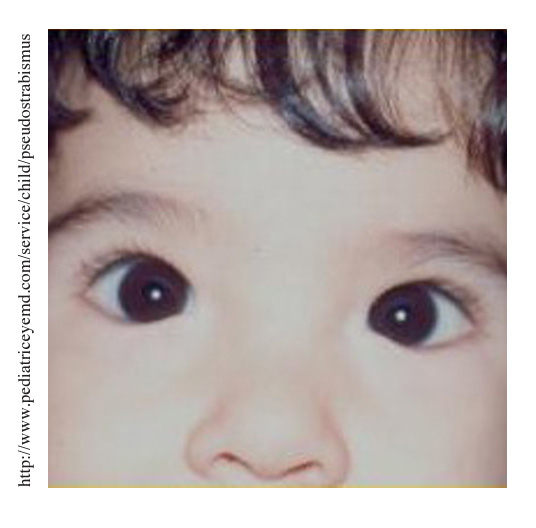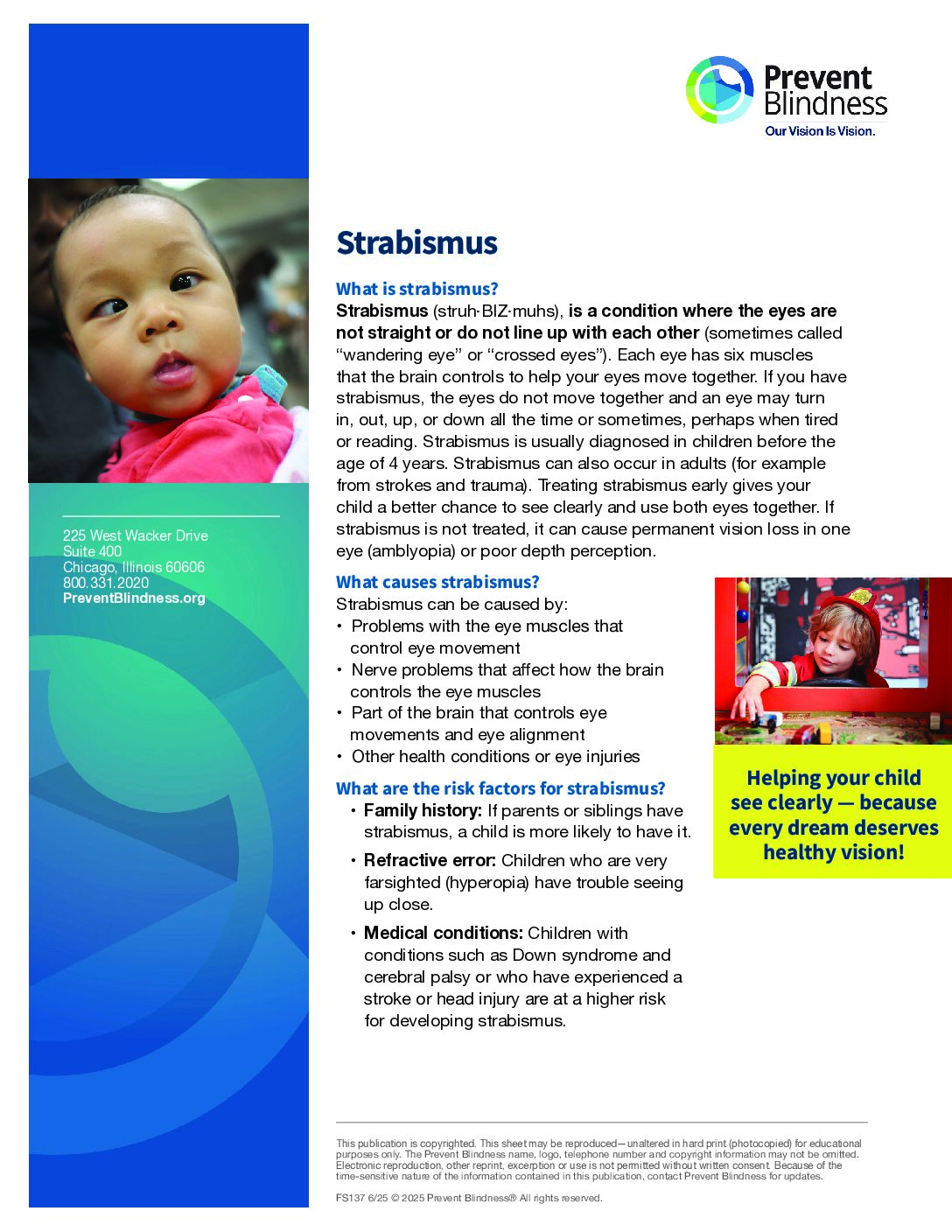Strabismus is a word for eyes that are not straight or do not line up with each other. If the problem is not treated, it can cause amblyopia.
What Causes the Misalignment?
The misalignment in strabismus results from the failure of the eye muscles to work together. One eye, or sometimes both, may turn in (crossed eyes), turn out (wall eyes), turn up or turn down. Sometimes more than one of the ‘turns’ are present.
When Strabismus is Present, Will the Eyes Always Look Misaligned?
The deviation may be constant or it may come and go. In young children strabismus may vary not only from day-to-day, but during the course of a day.
 a child with strabismus that can lead to amblyopia (lazy eye)
a child with strabismus that can lead to amblyopia (lazy eye)
My Infant’s Eyes Roll All Over. Should I Be Concerned?
At birth, an infant’s eyes cannot always focus directly on objects. They may appear to move quite independently at first, sometimes crossing, and sometimes wandering outward. But by the age of three to four months, an infant’s eyes should have the ability to focus on small objects and the eyes should be straight or parallel. A six-month-old infant should be able to focus on both distant and near objects.
What Should I Do If I Notice Wandering Eyes in My Four-month-old Child?
If parents notice crossed or wall eyes persisting in a child four months of age, they should immediately take the child to an eye care professional for an examination. Early medical attention is recommended for another important reason—to rule out the presence of a serious disease, such as a tumor.
What if My Baby Appears Completely Healthy?
During regular well baby exams, from birth to 2 years of age, pediatricians should use history and a vision evaluation to see if vision problems exist.
If there is any concern of an eye or vision problem the child should be referred for a comprehensive professional eye examination by an eye doctor.
Is Strabismus Present at Birth?
Strabismus may be present at birth, it may become apparent at a later age or it may appear at any time in life as a result of illness or accident.
Is It Important to Detect Strabismus Early?
It is critical that this condition be diagnosed and corrected at an early age since children with uncorrected strabismus may go on to develop amblyopia.
What is False or Pseudo-strabismus?
Certain children may appear to have strabismus when, in fact, they do not. An extra fold of skin near the inner eye, a broad, flat nose or eyes that are unusually close together may also produce the effect of false (or pseudo) strabismus. False strabismus should disappear as the child’s face grows.
After an eye exam by an eye doctor, a parent’s concern can be quickly dispelled if false strabismus is present.
What Treatment is Available for Strabismus?
Strabismus cannot be outgrown, nor will it improve by itself. Treatment to straighten the eyes is required.
¿Qué es el estrabismo?
Estrabismo es una palabra que se emplea para referirse a los ojos que no están derechos o que no se alinean entre sí. Este problema se produce cuando los músculos de los ojos no trabajan juntos. Aproximadamente uno de cada 50 niños en Estados Unidos tiene estrabismo. La mitad de estos niños nace con la afección. Una enfermedad o un accidente también pueden causar estrabismo. Si el problema no se detecta y no se trata a tiempo, puede derivar en ojo perezoso (ambliopía), una pérdida de la visión que no ha sido corregida con anteojos.
¿Por qué el estrabismo puede ocasionar pérdida de la visión?
Para desarrollar una visión normal, un niño necesita dos ojos sanos, ambos con buena visión, que funcionen bien juntos. Si los músculos de ambos ojos no funcionan juntos, el cerebro de su hijo puede comenzar a ignorar las imágenes del ojo que no mira directamente al objeto. Cuando el cerebro ignora la información visual de un ojo, ese ojo no desarrollará una buena visión. El estrabismo también puede afectar la personalidad de su hijo. Un defecto estético que hace que un niño se vea diferente puede causar sensación de vergüenza.
Busque signos que indiquen que los ojos de su hijo no se alinean.
Un niño con estrabismo puede tener ojos que se ven igual a una de estas imágenes:
- Ojo torcido hacia adentro
- Ojo torcido hacia afuera
- Ojo torcido hacia arriba
- Ojo torcido hacia abajo
Bebés
Los ojos de un bebé recién nacido algunas veces pueden parecer que tienen mirada errante o son bizcos. A los 3 ó 4 meses, los ojos de un bebé deben estar alineados entre sí. Un bebé de 9 meses de edad debe poder fijar sus ojos en objetos que están cerca o lejos.
LOS OJOS DE LOS BEBÉS RECIÉN NACIDOS DEBEN CONTROLARSE MIENTRAS ÉSTOS AÚN ESTÁN EN LA SALA DE RECIÉN NACIDOS DEL HOSPITAL.
Si nota ojos bizcos o torcidos hacia afuera en su hijo después de que el bebé tiene 3 meses de edad, lleve a su hijo a un médico oftalmólogo de inmediato. Los ojos de todos los niños deben controlarse a los 6 meses de edad.
3 a 4 años de edad
La edad preescolar también es muy importante para la vista de su hijo. Revise si hay signos de que los ojos de su hijo no se alinean o de que uno o ambos tengan mirada errante
Podemos ayudarlo a obtener más información sobre cómo proteger la vista de su hijo.
Si tiene preguntas sobre el estrabismo o si le gustaría obtener más información, llame a Prevent Blindness al 800-331-2020.


 a child with strabismus that can lead to amblyopia (lazy eye)
a child with strabismus that can lead to amblyopia (lazy eye)

